Kuppan T. Heat Exchanger Design Handbook
Подождите немного. Документ загружается.

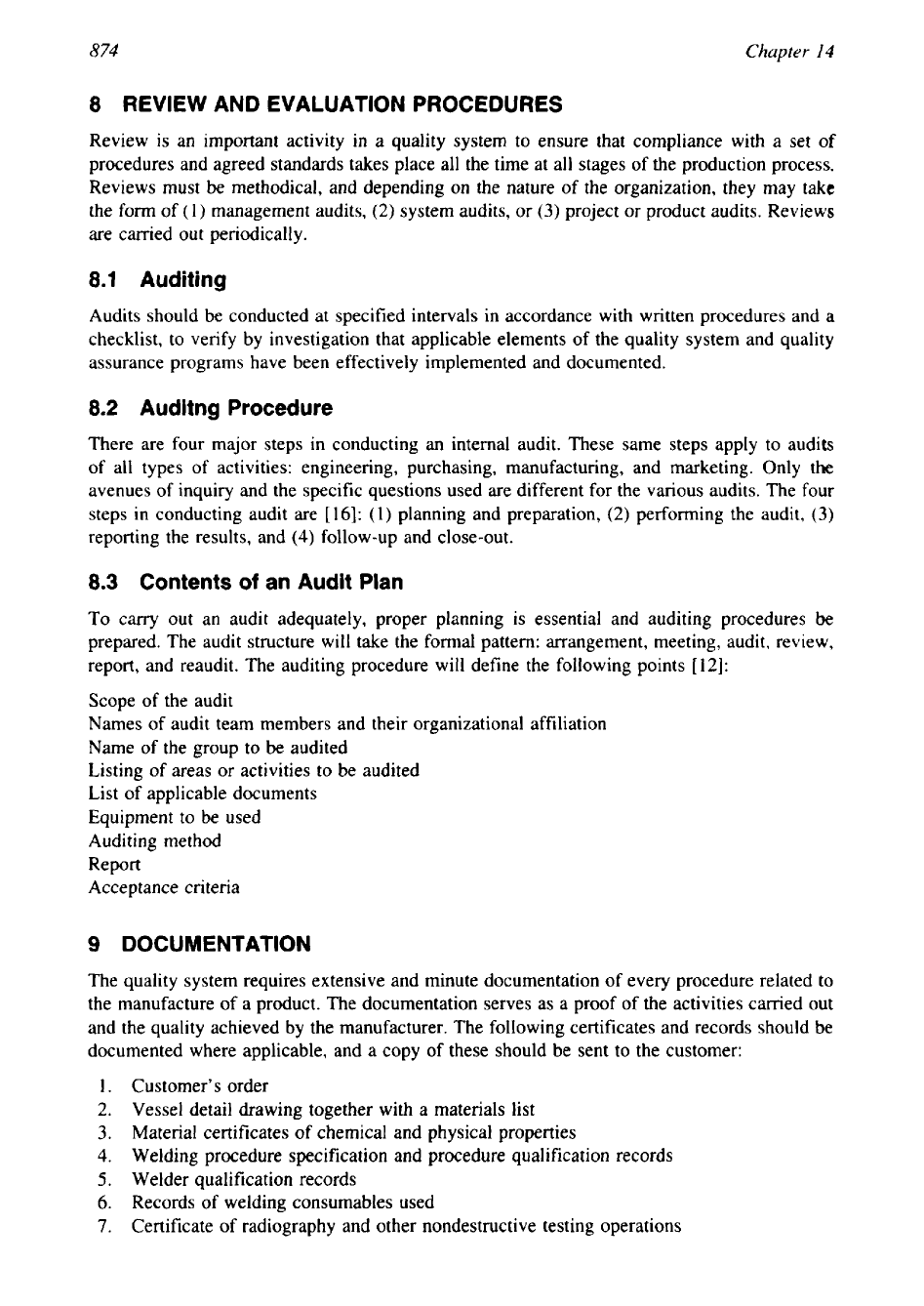
874
Chapter
14
8
REVIEW AND EVALUATION PROCEDURES
Review is an important activity
in
a quality system to ensure that compliance with a set
of
procedures and agreed standards takes place all the time at all stages of the production process.
Reviews must be methodical, and depending on the nature of the organization, they may take
the form of
(I)
management audits,
(2)
system audits, or
(3)
project or product audits. Reviews
are carried out periodically.
8.1
Auditing
Audits should be conducted at specified intervals in accordance with written procedures and
a
checklist, to verify by investigation that applicable elements of the quality system and quality
assurance programs have been effectively implemented and documented.
8.2
Auditng Procedure
There are four major steps in conducting an internal audit. These same steps apply to audits
of all types of activities: engineering, purchasing, manufacturing, and marketing. Only the
avenues of inquiry and the specific questions used are different for the various audits. The four
steps in conducting audit are
[16]:
(1)
planning and preparation,
(2)
performing the audit,
(3)
reporting the results, and
(4)
follow-up and close-out.
8.3
Contents
of
an Audit Plan
To carry out an audit adequately, proper planning is essential and auditing procedures
be
prepared. The audit structure will take the formal pattern: arrangement, meeting, audit, review,
report, and reaudit. The auditing procedure will define the following points
[
121:
Scope of the audit
Names of audit team members and their organizational affiliation
Name of the group to be audited
Listing
of
areas or activities to be audited
List of applicable documents
Equipment to be used
Auditing method
Report
Acceptance criteria
9
DOCUMENTATION
The quality system requires extensive and minute documentation of every procedure related to
the manufacture of a product. The documentation serves as a proof of the activities carried out
and the quality achieved by the manufacturer. The following certificates and records should be
documented where applicable, and a copy
of
these should be sent to the customer:
1.
Customer’s order
2.
Vessel detail drawing together with a materials list
3.
Material certificates
of
chemical and physical properties
4.
Welding procedure specification and procedure qualification records
5.
Welder qualification records
6.
Records
of
welding consumables used
7.
Certificate of radiography and other nondestructive testing operations
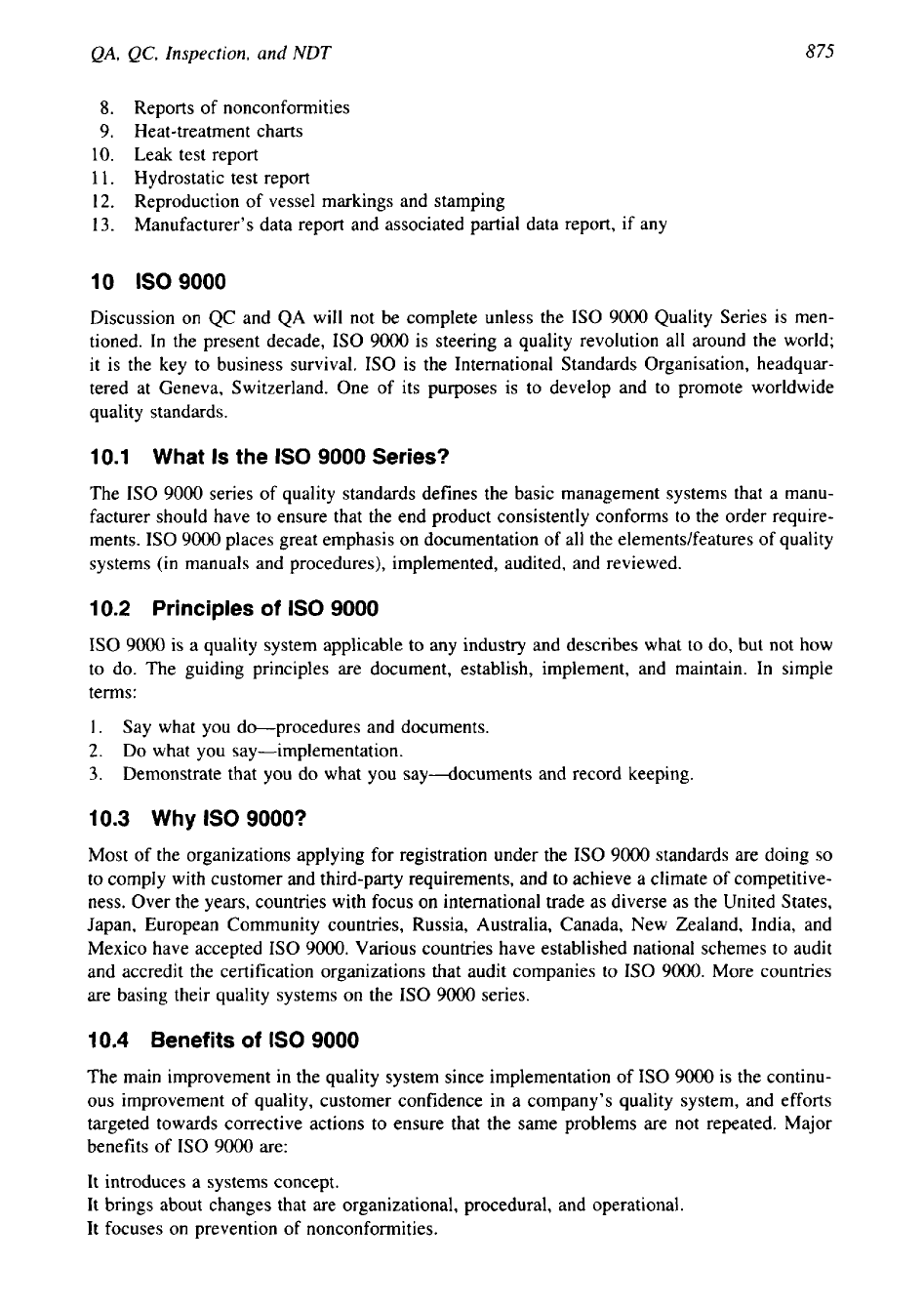
QA,
QC,
Inspection,
and
NDT
875
8.
Reports of nonconformities
9. Heat-treatment charts
10.
Leak test report
11.
Hydrostatic test report
12.
Reproduction of vessel markings and stamping
13.
Manufacturer’s data report and associated partial data report, if any
10
IS0
9000
Discussion on QC and
QA
will not be complete unless the IS0 9000 Quality Series is men-
tioned. In the present decade,
IS0
9000
is steering a quality revolution all around the world;
it is the key to business survival. IS0 is the International Standards Organisation, headquar-
tered at Geneva, Switzerland. One of its purposes is to develop and to promote worldwide
quality standards.
10.1
What Is the
IS0
9000
Series?
The IS0 9000 series of quality standards defines the basic management systems that a manu-
facturer should have to ensure that the end product consistently conforms to the order require-
ments. IS0 9000 places great emphasis on documentation of all the elementdfeatures of quality
systems (in manuals and procedures), implemented, audited, and reviewed.
10.2
Principles of
IS0
9000
IS0 9000 is
a
quality system applicable to any industry and describes what to do, but not how
to do. The guiding principles are document, establish, implement, and maintain. In simple
terms:
1.
Say what you do-procedures and documents.
2. Do
what you say-implementation.
3.
Demonstrate that you do what you say-documents and record keeping.
10.3
Why
IS0
9000?
Most of the organizations applying for registration under the
IS0
9000
standards are doing
so
to comply with customer and third-party requirements, and
to
achieve a climate of competitive-
ness. Over the years, countries with focus on international trade as diverse as the United States,
Japan, European Community countries, Russia, Australia, Canada, New Zealand, India, and
Mexico have accepted IS0
9000.
Various countries have established national schemes to audit
and accredit the certification organizations that audit companies to
IS0
9000.
More countries
are basing their quality systems on the
IS0
9000 series.
10.4
Benefits of
IS0
9000
The main improvement in the quality system since implementation of
IS0
9000
is the continu-
ous improvement of quality, customer confidence in
a
company’s quality system, and efforts
targeted towards corrective actions to ensure that the same problems are not repeated. Major
benefits of
IS0
9000 are:
It introduces
a
systems concept.
It brings about changes that are organizational, procedural, and operational.
It focuses on prevention of nonconformities.
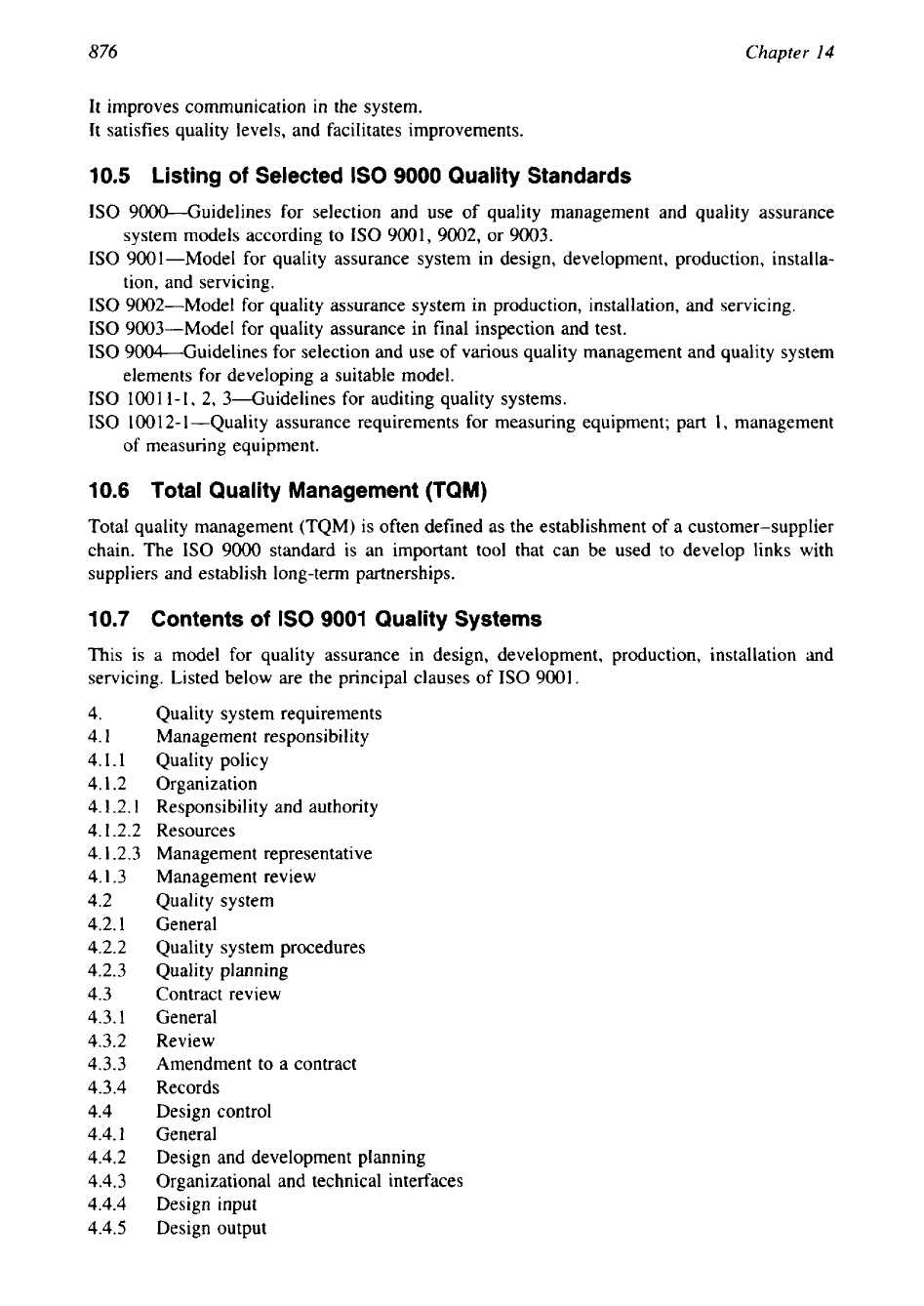
876
Chapter
14
It improves communication in the system.
It
satisfies quality levels, and facilitates improvements.
10.5
Listing
of
Selected
IS0
9000 Quality Standards
IS0 9000--Guidelines for selection and use of quality management and quality assurance
system models according to IS0 9001, 9002, or 9003.
IS0 900
1
-Model for quality assurance system in design, development, production, installa-
tion, and servicing.
IS0
9002-Model for quality assurance system in production, installation, and servicing.
IS0 9003-Model for quality assurance in final inspection and test.
IS0
9004-Guidelines for selection and use of various quality management and quality system
elements for developing a suitable model.
IS0
100
1
1
-
I,
2, 3-Guidelines for auditing quality systems.
IS0 1001 2- 1-Quality assurance requirements for measuring equipment; part
1,
management
of measuring equipment.
10.6 Total Quality Management
(TQM)
Total quality management
(TQM)
is often defined as the establishment
of
a customer-supplier
chain. The IS0 9000 standard is an important tool that can be used to develop links with
suppliers and establish long-term partnerships.
10.7 Contents
of IS0
9001 Quality Systems
This is a model for quality assurance in design, development, production, installation and
servicing. Listed below are the principal clauses of
IS0
9001.
4.
Quality system requirements
4.1
Management responsibility
4.1.1
Quality policy
4.1.2
Organization
4.1.2.1
Responsibility and authority
4.1.2.2
Resources
4.1.2.3
Management representative
4.1.3
Management review
4.2
Quality system
4.2.1
General
4.2.2
Quality system procedures
4.2.3
Quality planning
4.3
Contract review
4.3.1
General
4.3.2
Review
4.3.3
Amendment to a contract
4.3.4
Records
4.4
Design control
4.4.1
General
4.4.2
Design and development planning
4.4.3
Organizational and technical interfaces
4.4.4
Design input
4.4.5
Design output
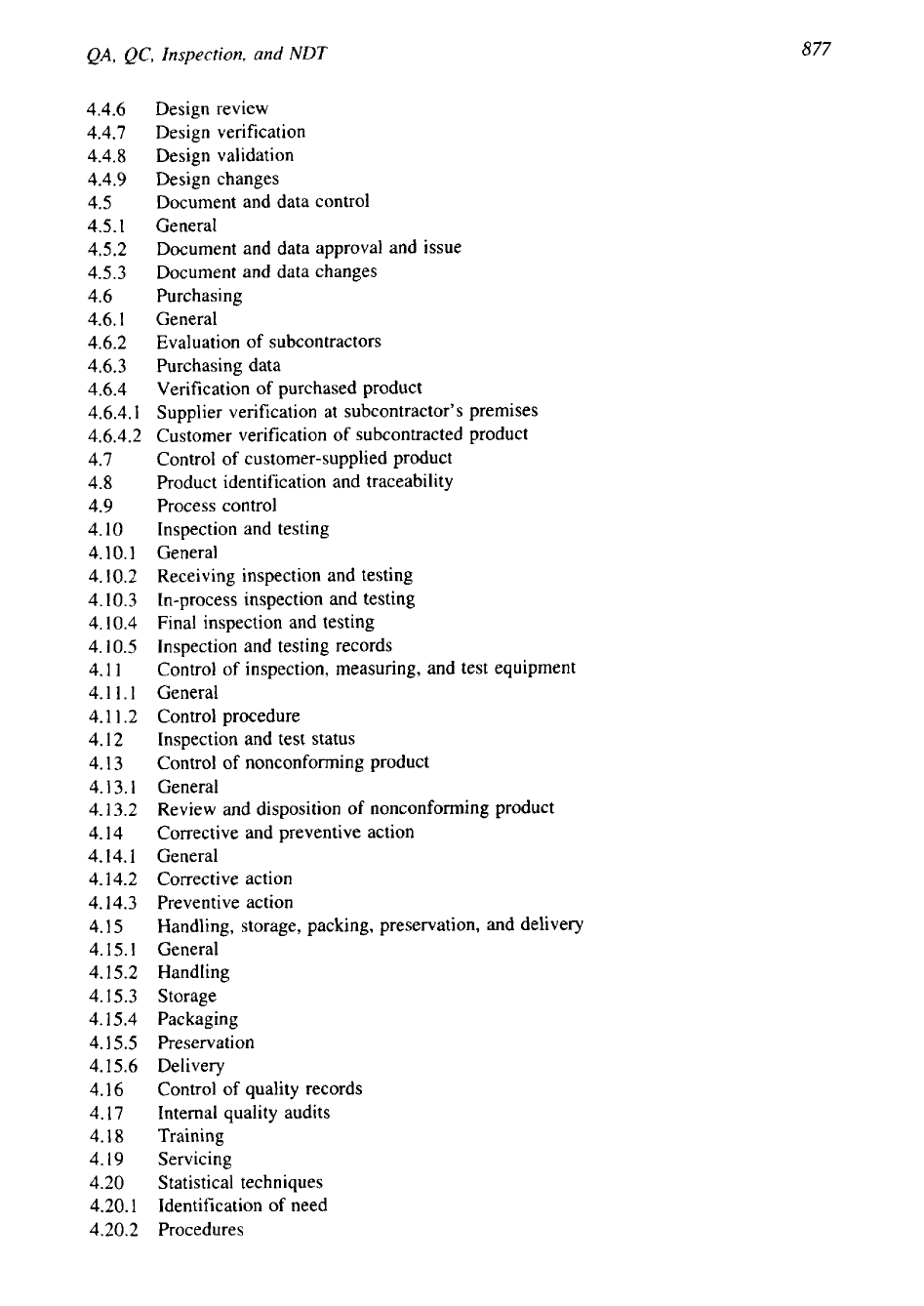
877
QA,
QC,
Inspection,
and
NDT
4.4.6
Design review
4.4.7
Design verification
4.4.8
Design validation
4.4.9
Design changes
4.5
Document and data control
4.5.1
General
4.5.2
Document and data approval and issue
4.5.3
Document and data changes
4.6
Purchasing
4.6.1
General
4.6.2
Evaluation
of
subcontractors
4.6.3
Purchasing data
4.6.4
Verification
of
purchased product
4.6.4.1
Supplier verification at subcontractor’s premises
4.6.4.2
Customer verification of subcontracted product
4.7
Control of customer-supplied product
4.8
Product identification and traceability
4.9
Process control
4.10
Inspection and testing
4.10.1
General
4.10.2
Receiving inspection and testing
4.10.3
In-process inspection and testing
4.10.4
Final inspection and testing
4.10.5
Inspection and testing records
4.1
1
Control
of
inspection, measuring, and test equipment
4.1
1.1
General
4.11.2
Control procedure
4.12
Inspection and test status
4.13
Control of nonconforming product
4.13.1
General
4.13.2
Review and disposition of nonconforming product
4.14
Corrective and preventive action
4.14.1
General
4.14.2
Corrective act ion
4.14.3
Preventive action
4.15
Handling, storage, packing, preservation, and delivery
4.15.1
General
4.15.2
Handling
4.15.3
Storage
4.15.4
Packaging
4.15.5
Preservation
4.15.6
Delivery
4.16
Control
of
quality records
4.17
Internal quality audits
4.18
Training
4.19
Servicing
4.20
Statistical techniques
4.20.1
Identification of need
4.20.2
Procedures
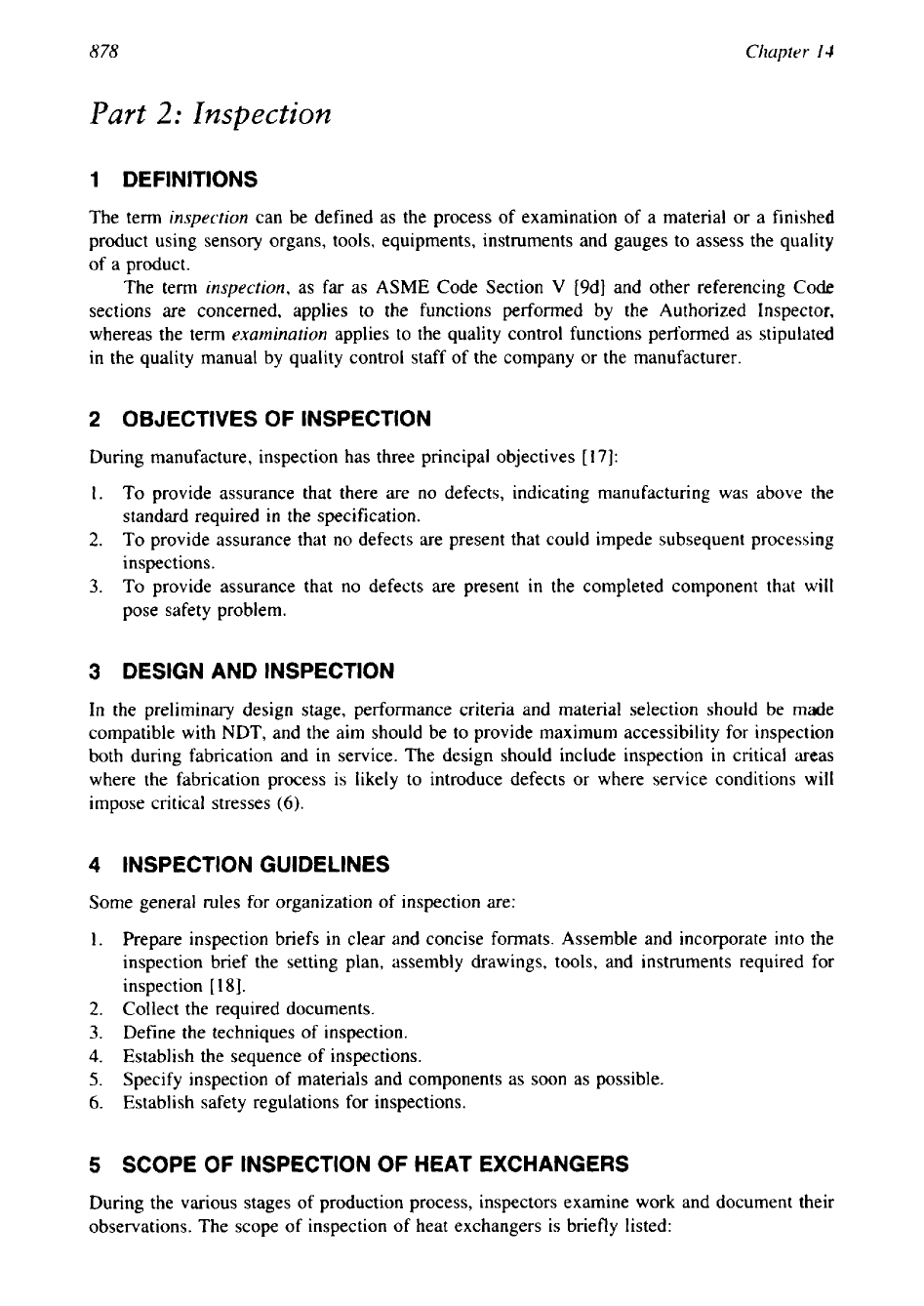
878
Chupter
I4
Part
2:
Inspection
1
DEFINITIONS
The term
inspection
can be defined as the process of examination of a material or a finished
product using sensory organs, tools, equipments, instruments and gauges to assess the quality
of a product.
The term
inspection,
as far as ASME Code Section
V
[9d] and other referencing
Code
sections are concerned, applies
to
the functions performed by the Authorized Inspector,
whereas the term
examination
applies to the quality control functions performed as stipulated
in the quality manual by quality control staff of the company or the manufacturer.
2
OBJECTIVES
OF
INSPECTION
During manufacture, inspection has three principal objectives
[
171:
1.
To provide assurance that there are no defects, indicating manufacturing was above the
standard required
in
the specification.
2.
To provide assurance that no defects are present that could impede subsequent processing
inspections.
3.
To
provide assurance that no defects are present in the completed component that will
pose safety problem.
3
DESIGN AND INSPECTION
In the preliminary design stage, performance criteria and material selection should be made
compatible with NDT, and the aim should be to provide maximum accessibility for inspection
both during fabrication and in service. The design should include inspection in critical
areas
where the fabrication process is likely to introduce defects or where service conditions will
impose critical stresses
(6).
4
INSPECTION GUIDELINES
Some general rules for organization
of
inspection are:
1.
Prepare inspection briefs in clear and concise formats. Assemble and incorporate into the
inspection brief the setting plan, assembly drawings, tools, and instruments required for
inspection
[
1
81.
2.
Collect the required documents.
3.
Define the techniques of inspection.
4.
Establish the sequence of inspections.
5.
Specify inspection of materials and components as
soon
as possible.
6.
Establish safety regulations for inspections.
5
SCOPE OF INSPECTION OF HEAT EXCHANGERS
During the various stages of production process, inspectors examine work and document their
observations. The scope of inspection of heat exchangers is briefly listed:
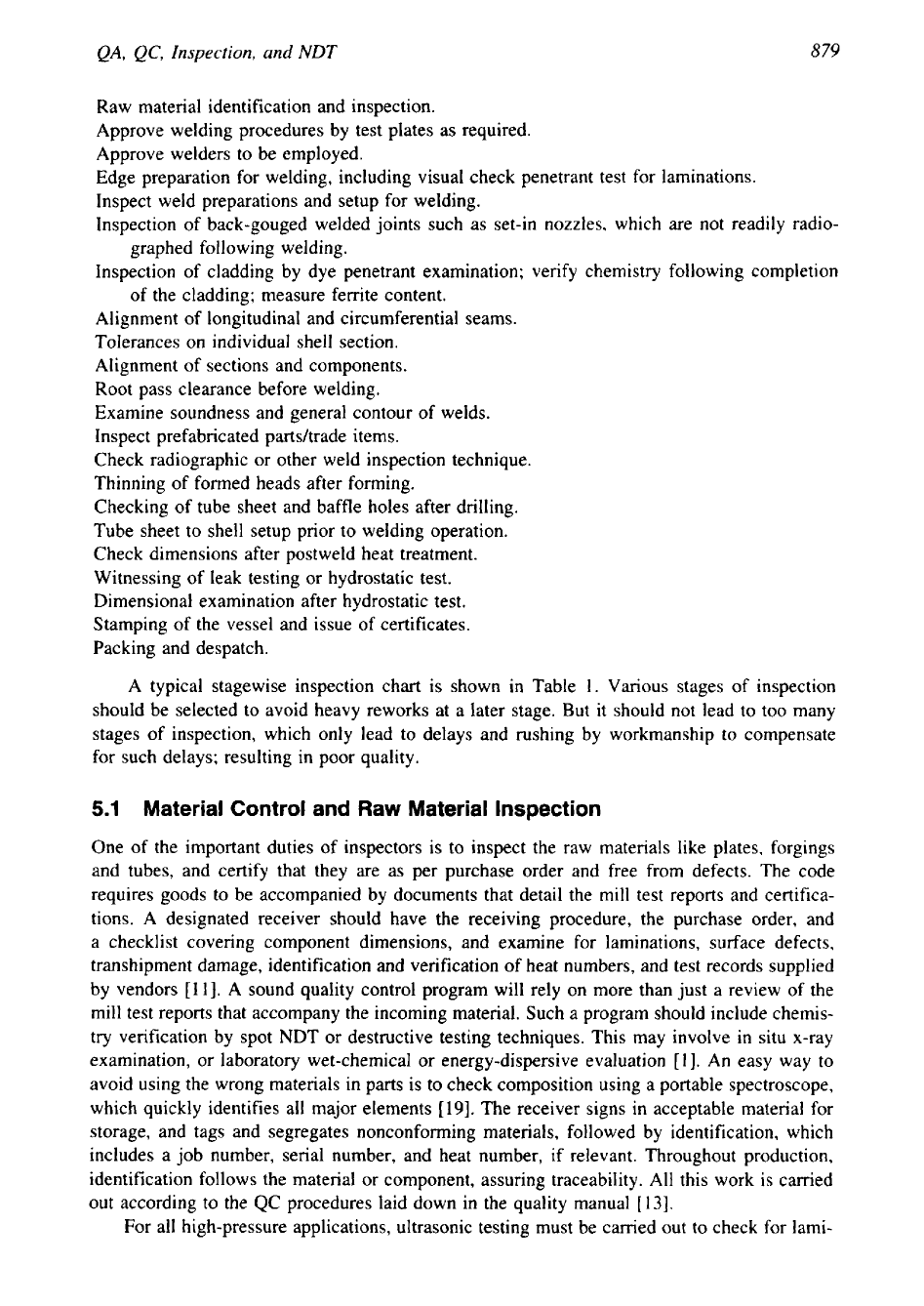
QA,
QC,
Inspection,
and
NDT
879
Raw material identification and inspection.
Approve welding procedures by test plates as required.
Approve welders to be employed.
Edge preparation for welding, including visual check penetrant test for laminations.
Inspect weld preparations and setup for welding.
Inspection
of
back-gouged welded joints such as set-in nozzles, which are not readily radio-
graphed following welding.
Inspection of cladding by dye penetrant examination; verify chemistry following completion
of the cladding; measure ferrite content.
Alignment of longitudinal and circumferential seams.
Tolerances on individual shell section.
Alignment of sections and components.
Root pass clearance before welding.
Examine soundness and general contour of welds.
Inspect prefabricated partshrade items.
Check radiographic or other weld inspection technique.
Thinning of formed heads after forming.
Checking of tube sheet and baffle holes after drilling.
Tube sheet to shell setup prior to welding operation.
Check dimensions after postweld heat treatment.
Witnessing of leak testing or hydrostatic test.
Dimensional examination after hydrostatic test.
Stamping
of
the vessel and issue of certificates.
Packing and despatch.
A typical stagewise inspection chart is shown in Table 1. Various stages of inspection
should be selected to avoid heavy reworks at a later stage. But it should not lead to too many
stages
of
inspection, which only lead to delays and rushing by workmanship to compensate
for such delays; resulting in poor quality.
5.1
Material Control and
Raw
Material Inspection
One of the important duties of inspectors is to inspect the raw materials like plates, forgings
and tubes, and certify that they are as per purchase order and free from defects. The code
requires goods to be accompanied by documents that detail the mill test reports and certifica-
tions. A designated receiver should have the receiving procedure, the purchase order, and
a checklist covering component dimensions, and examine for laminations, surface defects,
transhipment damage, identification and verification
of
heat numbers, and test records supplied
by vendors
[l
13.
A
sound quality control program will rely on more than just a review of the
mill test reports that accompany the incoming material. Such a program should include chemis-
try verification by spot NDT or destructive testing techniques. This may involve in situ x-ray
examination,
or
laboratory wet-chemical or energy-dispersive evaluation
[I].
An easy way to
avoid using the wrong materials in parts is to check composition using a portable spectroscope,
which quickly identifies all major elements
[19].
The receiver signs in acceptable material for
storage, and tags and segregates nonconforming materials, followed by identification, which
includes a job number, serial number, and heat number, if relevant. Throughout production,
identification follows the material or component, assuring traceability. All this work is carried
out according to the
QC
procedures laid down in
the
quality manual
[
131.
For all high-pressure applications, ultrasonic testing must be carried out to check for lami-
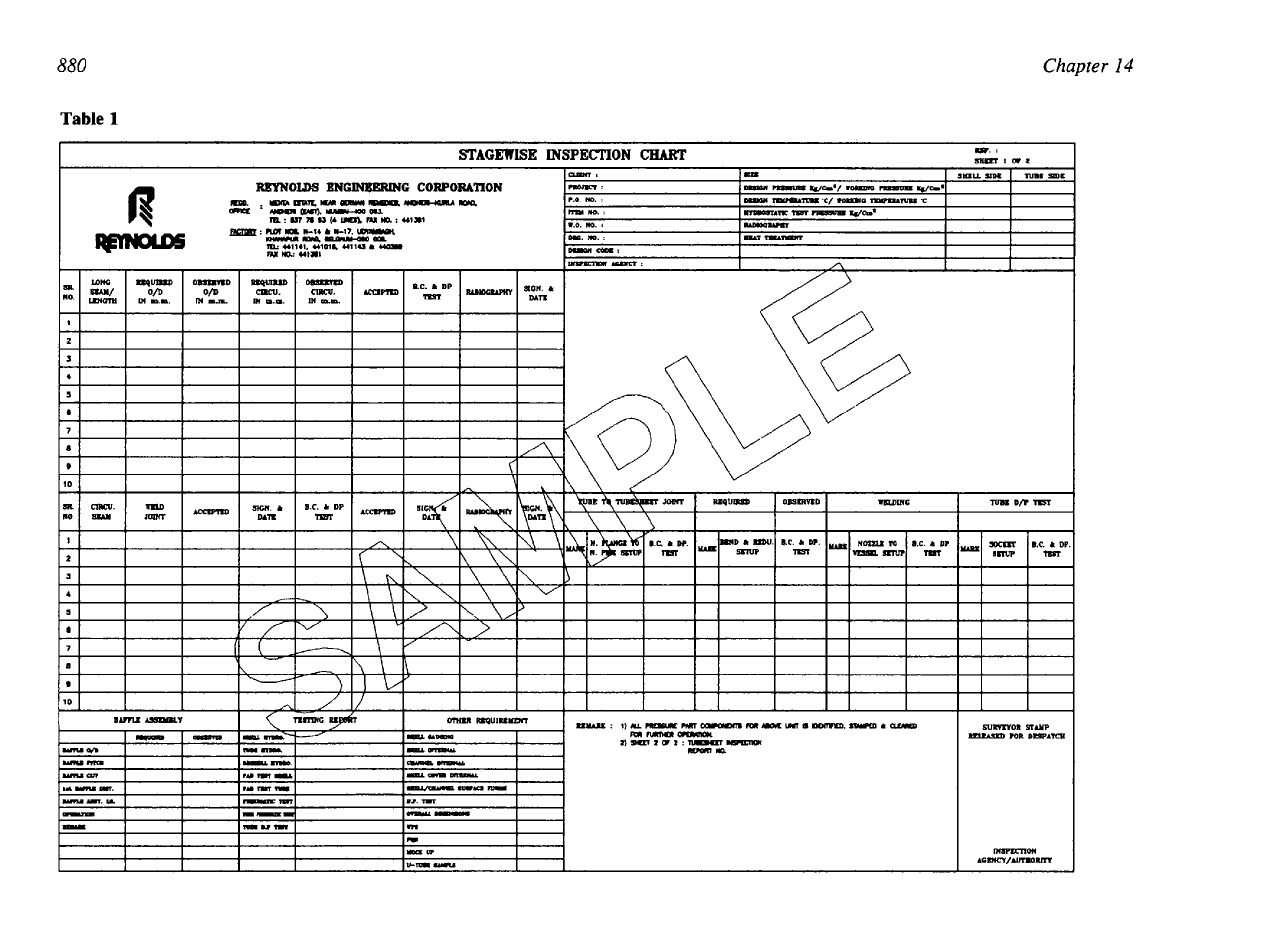
880
Chapter
14
Table
1
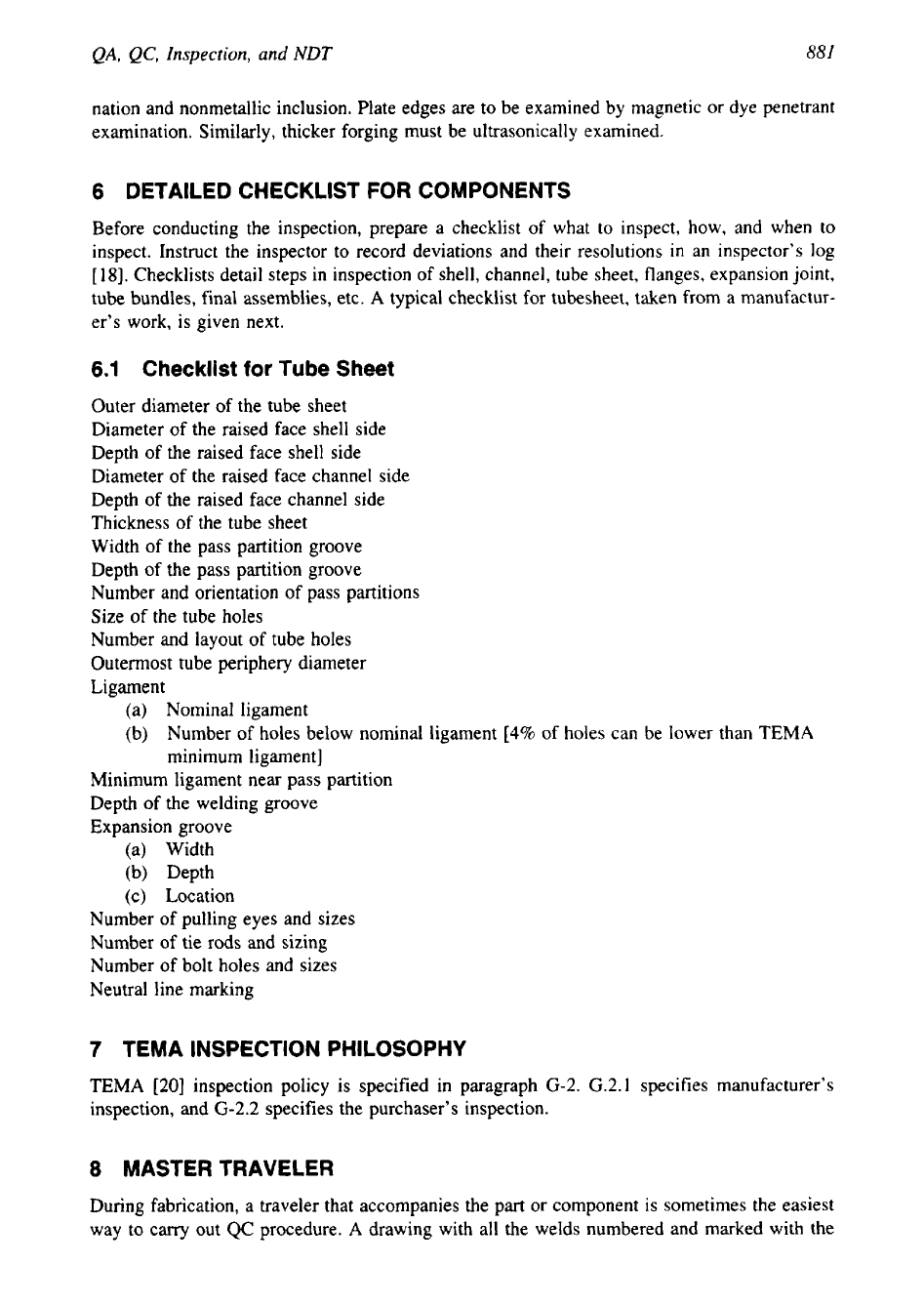
QA,
QC,
Inspection,
and
NDT
881
nation and nonmetallic inclusion. Plate edges are to be examined by magnetic or dye penetrant
examination. Similarly, thicker forging must be ultrasonically examined,
6
DETAILED CHECKLIST
FOR
COMPONENTS
Before conducting the inspection, prepare a checklist of what to inspect, how, and when to
inspect. Instruct the inspector to record deviations and their resolutions
in
an inspector’s log
[
181.
Checklists detail steps in inspection of shell, channel, tube sheet, flanges, expansion joint,
tube bundles, final assemblies, etc.
A
typical checklist for tubesheet, taken from a manufactur-
er’s work, is given next.
6.1
Checklist
for
Tube Sheet
Outer diameter of the tube sheet
Diameter of the raised face shell side
Depth
of
the raised face shell side
Diameter of the raised face channel side
Depth
of
the raised face channel side
Thickness of the tube sheet
Width of the pass partition groove
Depth of the pass partition groove
Number and orientation of pass partitions
Size of the tube holes
Number
and
layout
of
tube holes
Outermost tube periphery diameter
Ligament
(a) Nominal ligament
(b) Number of holes below nominal ligament
[4%
of holes can be lower than
TEMA
minimum ligament]
Minimum ligament near pass partition
Depth of the welding groove
Expansion groove
(a) Width
(b) Depth
(c) Location
Number of pulling eyes and sizes
Number
of
tie
rods
and sizing
Number of bolt holes and sizes
Neutral line marking
7
TEMA INSPECTION PHILOSOPHY
TEMA
[20]
inspection policy is specified in paragraph
G-2. G.2.1
specifies manufacturer’s
inspection, and
G-2.2
specifies the purchaser’s inspection.
8
MASTERTRAVELER
During fabrication, a traveler that accompanies the part or component is sometimes the easiest
way to carry out
QC
procedure.
A
drawing with all the welds numbered and marked with the
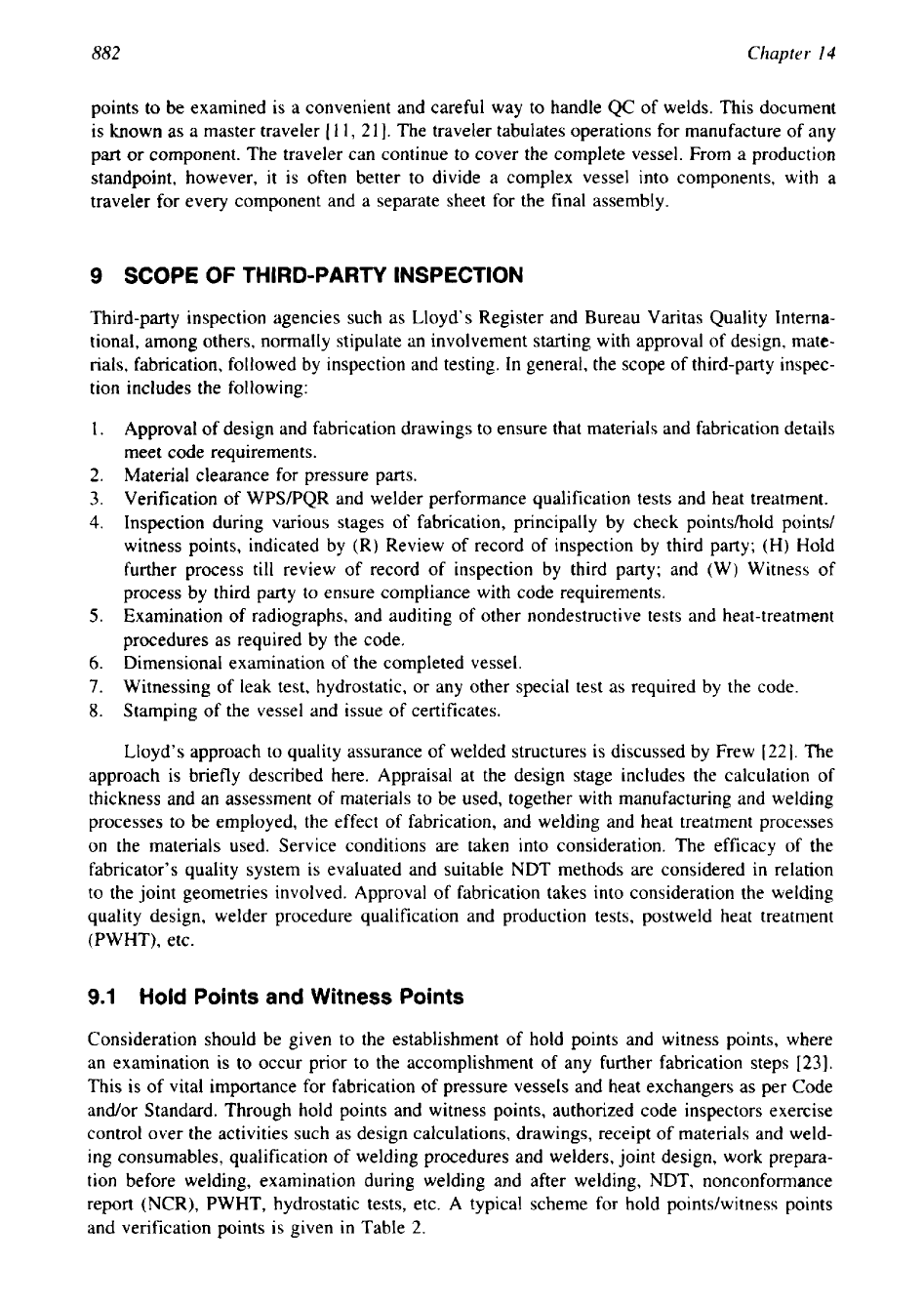
882
Chapter
14
points to be examined is a convenient and careful way to handle QC of welds. This document
is known as a master traveler
[
1
1,
2
11.
The traveler tabulates operations for manufacture of any
part or component. The traveler can continue to cover the complete vessel. From a production
standpoint, however,
it
is often better to divide a complex vessel into components, with a
traveler for every component and a separate sheet for the final assembly.
9
SCOPE
OF THIRD-PARTY INSPECTION
Third-party inspection agencies such as Lloyd’
s
Register and Bureau Varitas Quality Interna-
tional, among others, normally stipulate an involvement starting with approval of design, mate-
rials, fabrication, followed by inspection and testing. In general, the scope of third-party inspec-
tion includes the following:
1.
Approval of design and fabrication drawings to ensure that materials and fabrication details
meet code requirements.
2.
Material clearance for pressure parts.
3.
Verification of WPSPQR and welder performance qualification tests and heat treatment.
4.
Inspection during various stages
of
fabrication, principally by check pointshold points/
witness points, indicated by (R) Review of record of inspection by third party; (H) Hold
further process till review of record of inspection by third party; and (W) Witness of
process by third party to ensure compliance with code requirements.
5.
Examination of radiographs, and auditing of other nondestructive tests and heat-treatment
procedures as required by the code.
6.
Dimensional examination
of
the completed vessel.
7.
Witnessing of leak test, hydrostatic, or any other special test as required by the code.
8.
Stamping of the vessel and issue of certificates.
Lloyd’s approach to quality assurance of welded structures is discussed by Frew
[22].
The
approach is briefly described here. Appraisal at the design stage includes the calculation of
thickness and an assessment of materials to be used, together with manufacturing and welding
processes to be employed, the effect of fabrication, and welding and heat treatment processes
on the materials used. Service conditions are taken into consideration. The efficacy of the
fabricator’s quality system is evaluated and suitable NDT methods are considered
in
relation
to the joint geometries involved. Approval of fabrication takes into consideration the welding
quality design, welder procedure qualification and production tests, postweld heat treatment
(PWHT), etc.
9.1
Hold
Points and Witness Points
Consideration should be given to the establishment of hold points and witness points, where
an examination is to occur prior to the accomplishment of any further fabrication steps
[23].
This is of vital importance for fabrication of pressure vessels and heat exchangers as per Code
andor Standard. Through hold points and witness points, authorized code inspectors exercise
control over the activities such as design calculations, drawings, receipt of materials and weld-
ing consumables, qualification of welding procedures and welders, joint design, work prepara-
tion before welding, examination during welding and after welding, NDT, nonconformance
report (NCR),
PWHT,
hydrostatic tests, etc.
A
typical scheme for hold points/witness points
and verification points is given in Table
2.
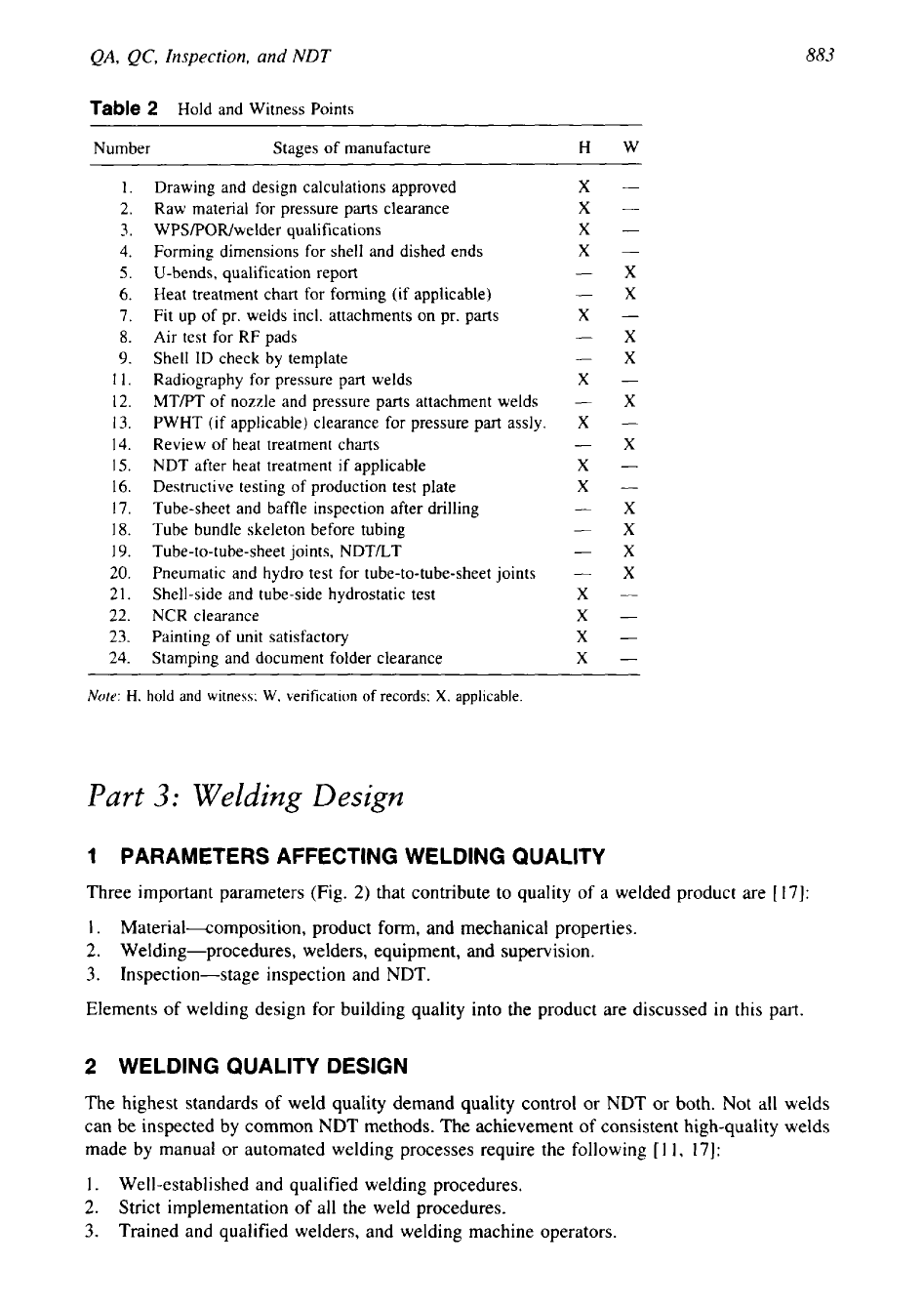
QA,
QC,
Inspection,
and
NDT
883
Table
2
Hold and Witness Points
Number Stages of manufacture H W
1.
Drawing and design calculations approved
2.
Raw material for pressure parts clearance
3.
WPS/POR/welder qualifications
4.
Forming dimensions for shell and dished ends
5.
U-bends, qualification report
6.
Heat treatment chart for forming (if applicable)
7.
Fit up of pr. welds incl. attachments on pr. parts
8.
Air
test for RF pads
9.
Shell
ID
check by template
11.
Radiography for pressure part welds
12.
MTPT of nozzle and pressure parts attachment welds
13.
PWHT (if applicable) clearance for pressure part assly.
14.
Review of heat treatment charts
15.
NDT after heat treatment
if
applicable
16.
Destructive testing of production test plate
17.
Tube-sheet and baffle inspection after drilling
18.
Tube bundle skeleton before tubing
19.
Tube-to-tube-sheet joints, NDTLT
20.
Pneumatic and hydro test for tube-to-tube-sheet joints
21.
Shell-side and tube-side hydrostatic test
22.
NCR clearance
23.
Painting of unit satisfactory
24.
Stamping and document folder clearance
Note:
H,
hold
and witness;
W,
verification
of
records;
X,
applicable.
Part
3:
Welding Design
1
PARAMETERS AFFECTING WELDING QUALITY
Three important parameters (Fig.
2)
that contribute to quality of
a
welded product are
[
171:
1.
Material-composition, product form, and mechanical properties.
2.
Welding-procedures, welders, equipment, and supervision.
3.
Inspection-stage inspection and NDT.
Elements
of
welding design for building quality into the product are discussed
in
this
part.
2
WELDING QUALITY DESIGN
The highest standards
of
weld quality demand quality control or NDT or both. Not all welds
can be inspected by common NDT methods. The achievement of consistent high-quality welds
made by manual or automated welding processes require the following
[
11,
171:
1.
Well-established and qualified welding procedures.
2.
Strict implementation
of
all the weld procedures.
3.
Trained and qualified welders, and welding machine operators.
